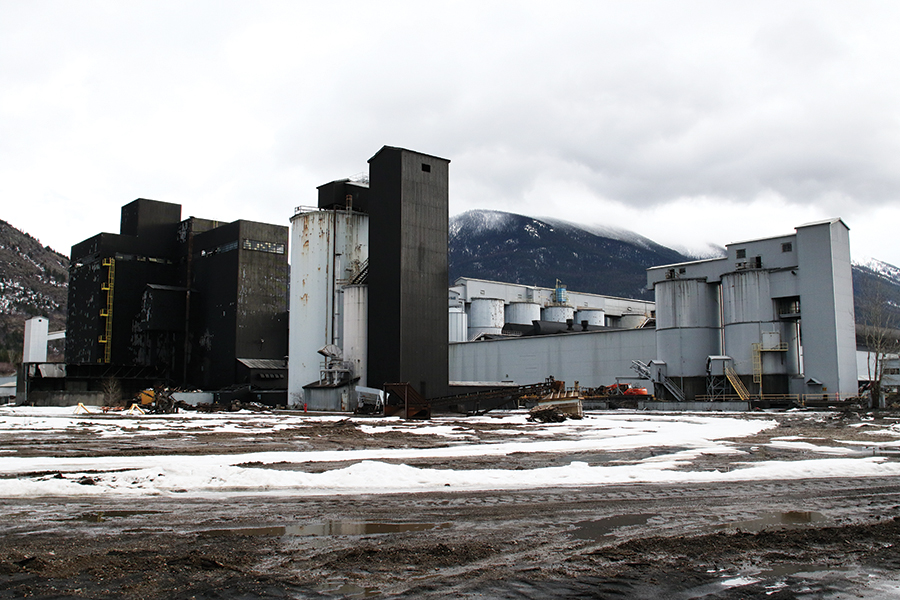Instead of the massive pot rooms that once pumped out millions of pounds of aluminum, dozens of local residents saw sprawling holes at the Columbia Falls Aluminum Co. during a public presentation and tour on May 9, a show of progress at the contaminated Environmental Protection Agency Superfund site that is in the midst of a years-long cleanup.
More than 50 people packed into a small conference room for a PowerPoint presentation led by representatives from CFAC, Roux Associates and the EPA, then boarded two school buses to tour both flattened pot rooms and an active monitoring well.
Since 2015, workers have been painstakingly dismantling the shuttered aluminum plant, which was declared a Superfund site — one recognized by EPA as among the most contaminated in the country — in 2016. Project managers say demolition of a 10th and final pot room, along with silos that once stored materials on site, will be completed by early 2019. The 45,000-cubic foot holes left by each pot room will eventually be filled with gravel, tour leaders said, and not all structures on the site will be demolished. John Stroiazzo, CFAC’s project manager, said the fabrication building, warehouses and the main office facility would remain standing and could, potentially, be used by other industrial businesses in the future. Any future occupation of the site, however, could not occur until after it is cleared by the EPA, likely no earlier than 2021.
During demolition, more than 29,000 tons of hazardous waste has been removed from the site and more than 131,000 tons of material (metals and carbon) have been recycled. Demolition work is being conducted by Calbag Resources under the supervision of the Montana Department of Environmental Quality.
In addition to the demolition, Roux Associates, with oversight from the EPA and DEQ, has been conducting what it calls a Remedial Investigation/Feasibility Study to identify contaminated areas at the site. Since 2016, Roux staff has monitored the groundwater through 64 wells and collected more than 900 samples of soil/sediment, groundwater and surface water.
Mike Ritoro of Roux Associates reiterated at the May 9 meeting that his company had discovered “high concentrations of cyanide and fluoride,” two poisonous and potentially dangerous chemicals, at CFAC in 2017. Those plumes of contamination, however, were found only in the areas closest to the main plant and on-site landfills, and no testing has revealed any contamination elsewhere on the 960-acre property. Groundwater on the site flows to the south-south west (toward the Flathead River), but samples taken down gradient of the contaminated areas showed no elevated levels of fluoride or cyanide, including those sampling sites closest to the so-called Aluminum City, a residential area directly down gradient of CFAC. Those findings were consistent through four different rounds of testing, in September 2016, December 2016, March 2017 and June 2017.
The second phase of the RI/FS is scheduled to begin this month, and will include continued sampling and analysis of the site. That work will include drilling eight new monitoring wells and adding 164 soil borings on the site, with more than 700 additional environmental samples scheduled to be collected. This second round of testing should be completed by March 2019, with a Human Health and Ecological Risk Assessment to follow by the end of that year. Once all testing is completed, EPA officials will determine how to address the contaminated areas with the goal of eventually rendering the entire site safe.
The May 9 public meeting was one of several that has been held since the project began in 2015. A local group, the CFAC Community Liaison Panel, also holds regular meetings with leaders of the project. The entire project at CFAC is not scheduled for completion until 2021.
CFAC first opened in 1955 and at one time employed more than 1,500 people at the plant, producing about 1 million pounds of aluminum per day. Glencore AG, a Swiss company, purchased CFAC in 1999 and the site closed in 2009. More information on cleanup efforts can be found at www.cfacproject.com.
